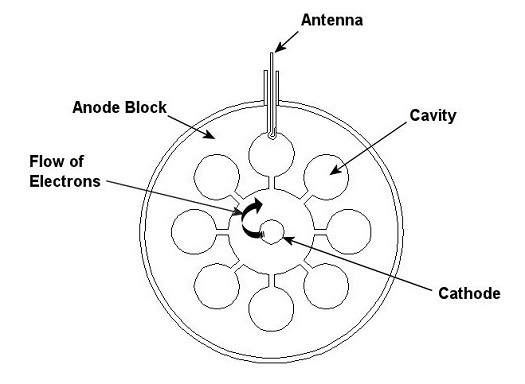| Ever discover a melted candy bar in your pocket? You immediately start to think about the sources for the heat that had caused the mess. Did you stand too close to the stove, were you outside in summer heat too long, or did you simply sit on it? Or was it perhaps caused by being in proximity to a whirring device, something which does not seem to generate any heat at all? If you’ve been reading along with us, you know what device I’m talking about.
Last time we talked about an effect known as cavity resonance and how a sound is created, much like a musical note, when we blow across the top of a glass pop bottle containing some air space. Our breath causes the air molecules to bounce in and out of the bottle’s cavity, producing the sound. Microwave technology works in much the same way, making use of an electronic device called a resonant-cavity magnetron. But instead of generating a musical tone, like our breath does over the bottle, the magnetron produces short wavelength radio waves, known as microwaves, and it was initially developed to generate these microwaves for radar systems. So, how does the magnetron work? The magnetron contains a series of cavities arranged in a circle, their openings pointed towards the center as shown in Figure 1. Engineers determined that when a high voltage, say 4000 volts, is applied to the magnetron, it begins to boil off electrons through a filament, called a cathode, located at its center. Once free of the cathode, the electrons want to flow to a part of the magnetron called the anode. This is because the cathode is positively charged and the anode is negatively charged, and as we know, electrons like to flow from positive to negative. The anode is also the part of the magnetron containing the cavities, and we’ll see the significance of this in a moment. Figure 1 – Interior View of a Resonant-Cavity Magnetron Before the electrons can take their desired straight path to the anode, they are deflected by powerful magnets located on either end of the magnetron. These magnets force the electrons to move in a circular pattern over the openings in the cavities. Like the air molecules passing over the top of a pop bottle when you blow across it, the electrons move over each cavity opening in the magnetron, creating not musical tones, but microwaves. The microwaves are then collected from the magnetron using an antenna and directed along a tube called a wave guide. The microwaves leave the wave guide when they are transmitted by radar systems. The radar system then transmits the microwaves towards moving objects they wish to track. These tracked objects are as diverse as airplanes, ships, and weather patterns. See Figure 2. Figure 2 – Microwave Radar Transmission So, how does the microwave oven fit into our discussion? In 1946 an engineer by the name of Percy Spencer was working on a radar magnetron for the Raytheon Corporation, a producer of electronic technology for industry and defense. During the course of his work he unexpectedly exposed himself to microwaves from a wave guide, and he couldn’t help but notice that the candy bar in his pocket had melted. Putting two plus two together, he realized the microwaves had caused the candy bar to heat up. Dr. Spencer further experimented and came to the conclusion that microwaves can cook foods far more quickly than conventional ovens, and the modern day kitchen appliance was soon born. Next time we’ll look at how Dr. Spencer’s microwave cooking discovery was developed into the microwave oven we find in most kitchens. We’ll also see how even an unplugged microwave oven can pose an electrocution hazard, as I explained in the Discovery Channel program I was recently featured on, Curious and Unusual Deaths. _____________________________________________ |
Engineering Expert Witness Blog
Published by Philip J. O'Keefe, PE, MLE





